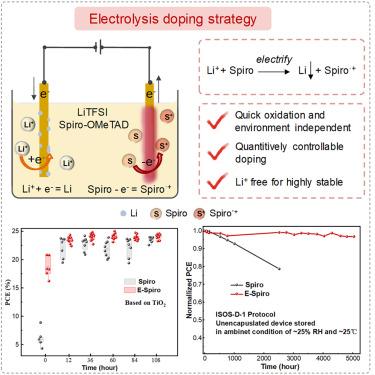Controllable electrolysis doping of organic semiconductors for stable perovskite solar cells
IF 35.4
1区 材料科学
Q1 CHEMISTRY, PHYSICAL
引用次数: 0
Abstract
The conventional doping method of organic semiconductors (commonly including lithium bis(trifluoromethane)sulfonimide [LiTFSI]) served as hole transport layers in perovskite solar cells (PSCs) suffers from a complex, time-consuming oxidation process, detrimentally impacting device stability. Herein, we propose a novel electrolysis doping strategy to modulate organic semiconductors, enabling controllable doping and effective Li⁺ removal. This electrolysis doping exploits holes with tunable oxidizing capabilities to oxidize organic semiconductors into ion radicals at the surface of the anode electrode, which exhibits a high reproducibility and a universal application on different organic semiconductors. Simultaneously, Li⁺ ions can be reduced to Li atoms at the surface of the cathode electrode, thus removing stability-damaging residual Li+. Accordingly, the regular PSCs using electrolyzed 2,2',7,7'-Tetrakis[N,N-di(4-methoxyphenyl)amino]-9,9'-spirobifluorene (Spiro) achieve a power conversion efficiency (PCE) of 26.16%, and the inverted-structured PSCs using electrolyzed poly[bis(4-phenyl) (2,4,6-trimethylphenyl)amine (PTAA) achieve a PCE of 25.57% with satisfying stability by maintaining 91% of initial efficiency after operating for 1,400 h under continuous one-sun illumination.

稳定钙钛矿太阳能电池用有机半导体可控电解掺杂
传统的有机半导体(通常包括锂二(三氟甲烷)磺酰亚胺[LiTFSI])掺杂方法作为钙钛矿太阳能电池(PSCs)的空穴传输层,存在复杂、耗时的氧化过程,对器件的稳定性产生不利影响。在这里,我们提出了一种新的电解掺杂策略来调制有机半导体,实现了可控的掺杂和有效的Li⁺去除。这种电解掺杂利用具有可调氧化能力的空穴在阳极电极表面将有机半导体氧化为离子自由基,具有较高的可重复性,在不同的有机半导体上具有普遍的应用前景。同时,Li+离子可以在阴极电极表面还原为Li原子,从而去除破坏稳定性的残余Li+。因此,使用电解2,2',7,7'-Tetrakis[N,N-di(4-甲氧基苯基)氨基]-9,9'- spirobi芴(Spiro)的常规PSCs的功率转换效率(PCE)为26.16%,而使用电解聚[双(4-苯基)(2,4,6-三甲基苯基)胺(PTAA)的反转结构PSCs的PCE为25.57%,在连续一次太阳照射1,400 h后保持91%的初始效率,具有满意的稳定性。
本文章由计算机程序翻译,如有差异,请以英文原文为准。
求助全文
约1分钟内获得全文
求助全文
来源期刊

Joule
Energy-General Energy
CiteScore
53.10
自引率
2.00%
发文量
198
期刊介绍:
Joule is a sister journal to Cell that focuses on research, analysis, and ideas related to sustainable energy. It aims to address the global challenge of the need for more sustainable energy solutions. Joule is a forward-looking journal that bridges disciplines and scales of energy research. It connects researchers and analysts working on scientific, technical, economic, policy, and social challenges related to sustainable energy. The journal covers a wide range of energy research, from fundamental laboratory studies on energy conversion and storage to global-level analysis. Joule aims to highlight and amplify the implications, challenges, and opportunities of novel energy research for different groups in the field.
 求助内容:
求助内容: 应助结果提醒方式:
应助结果提醒方式:


